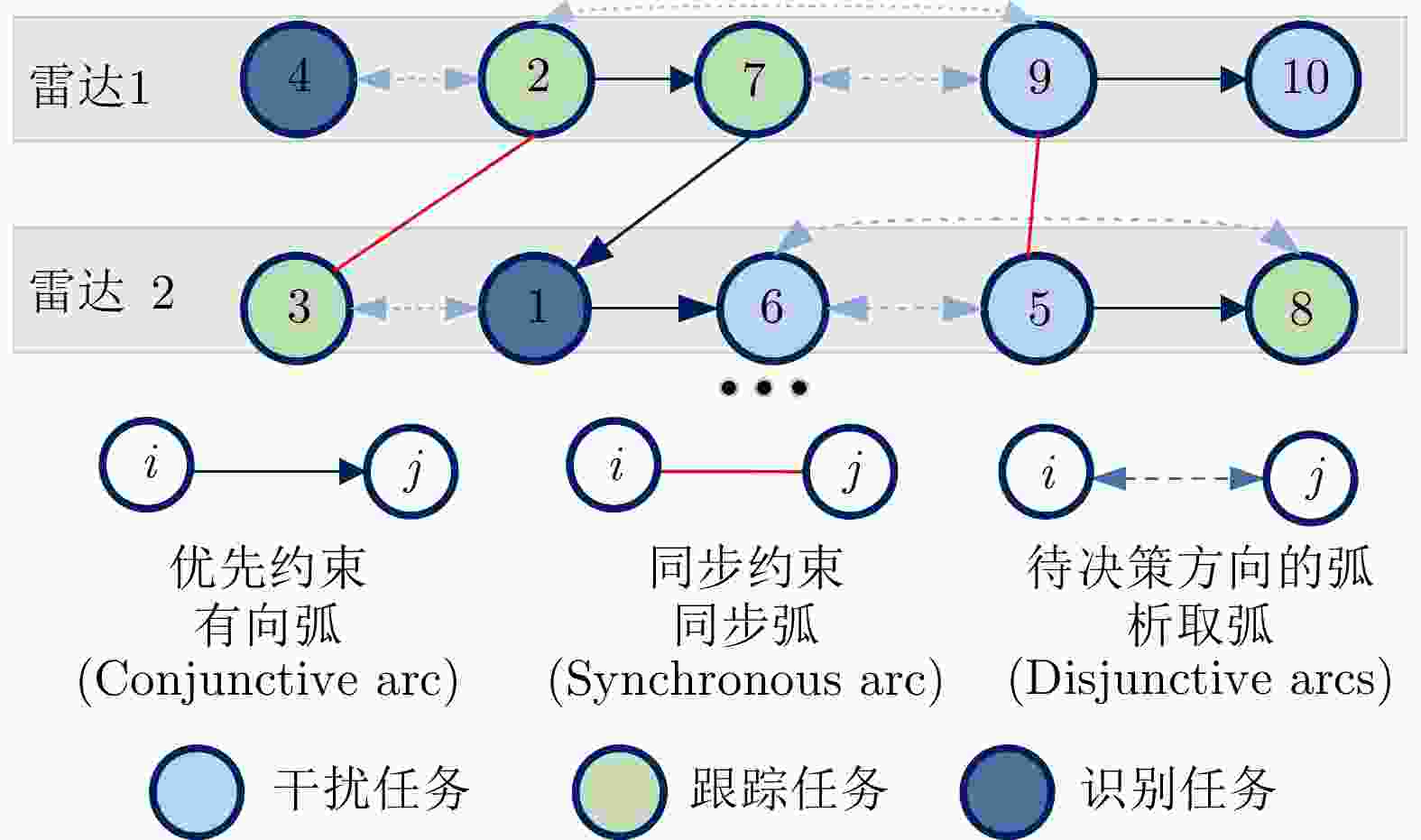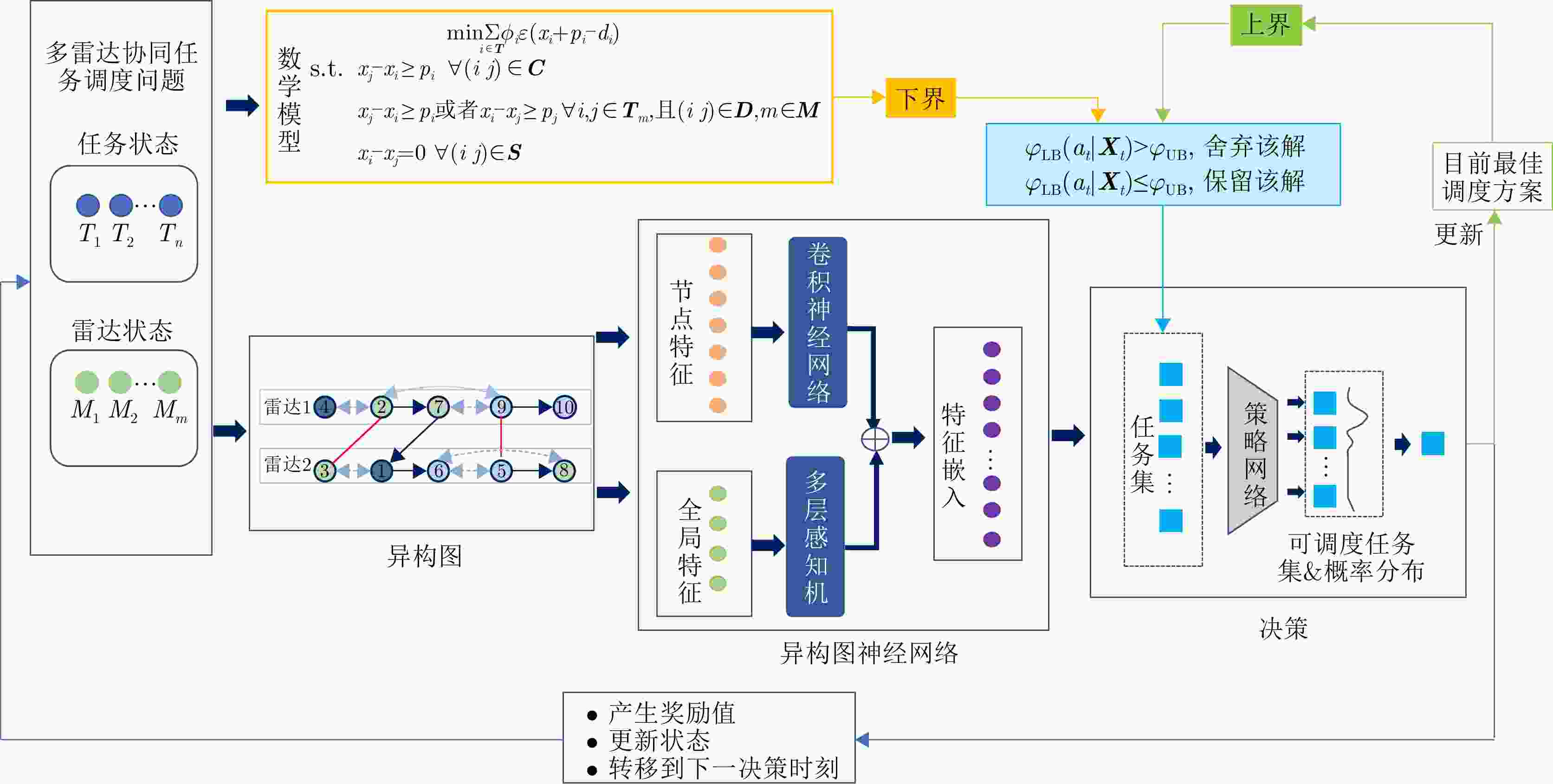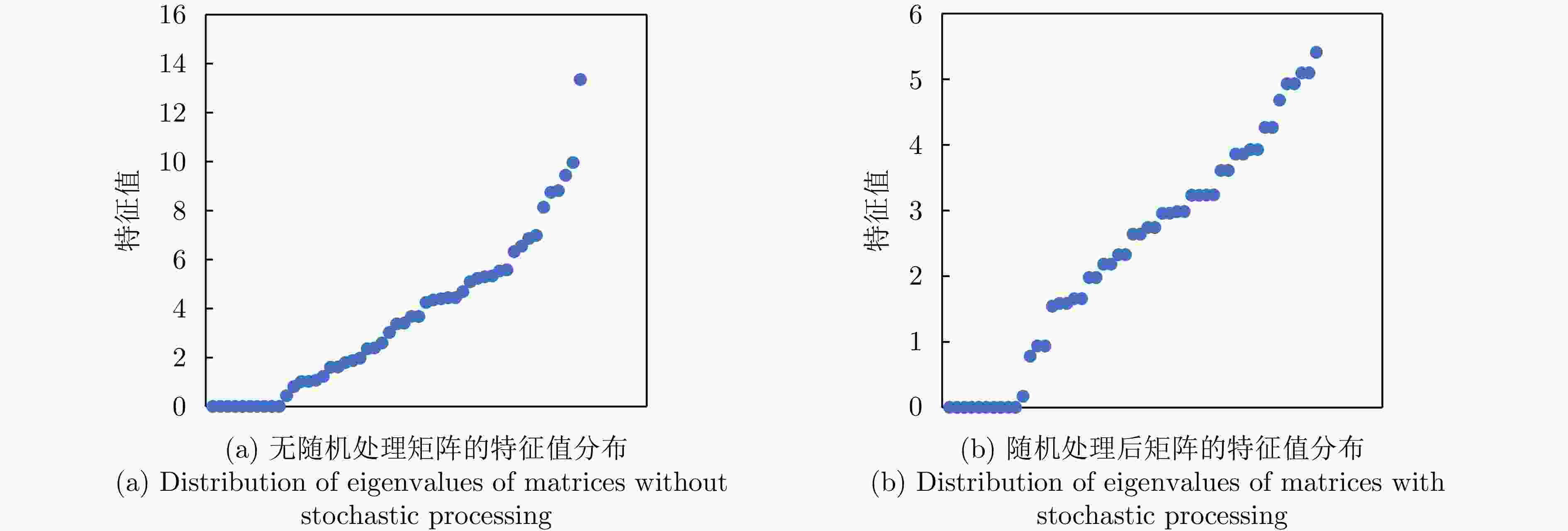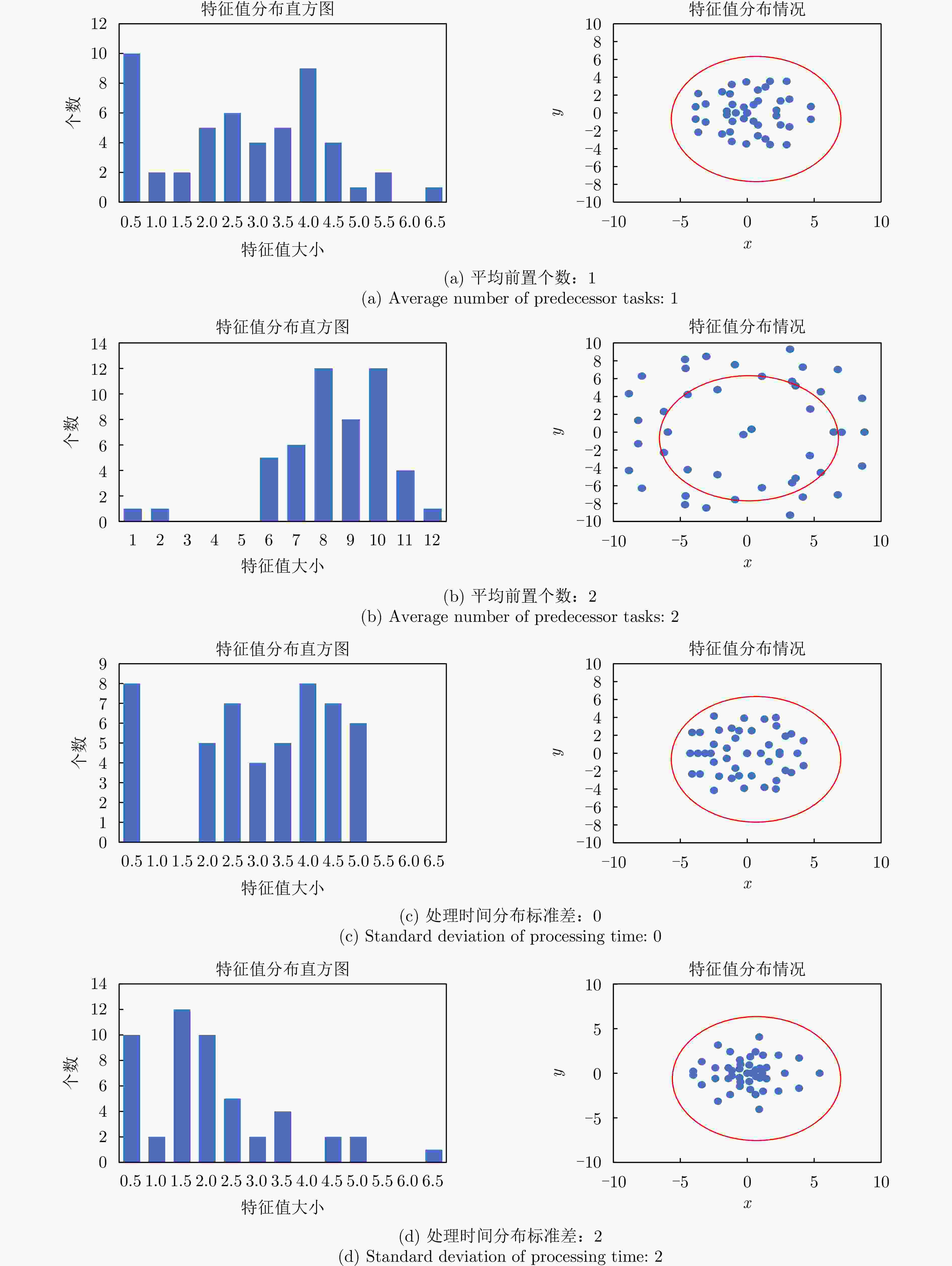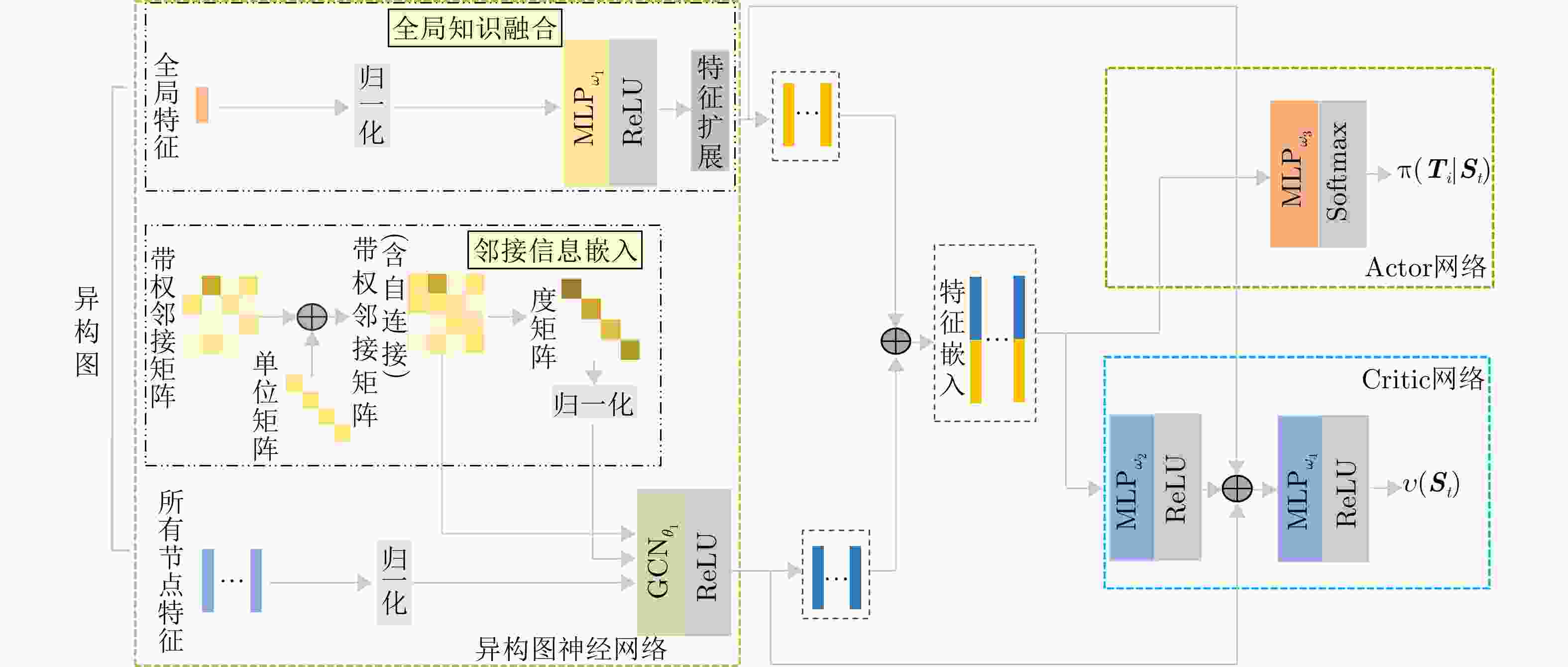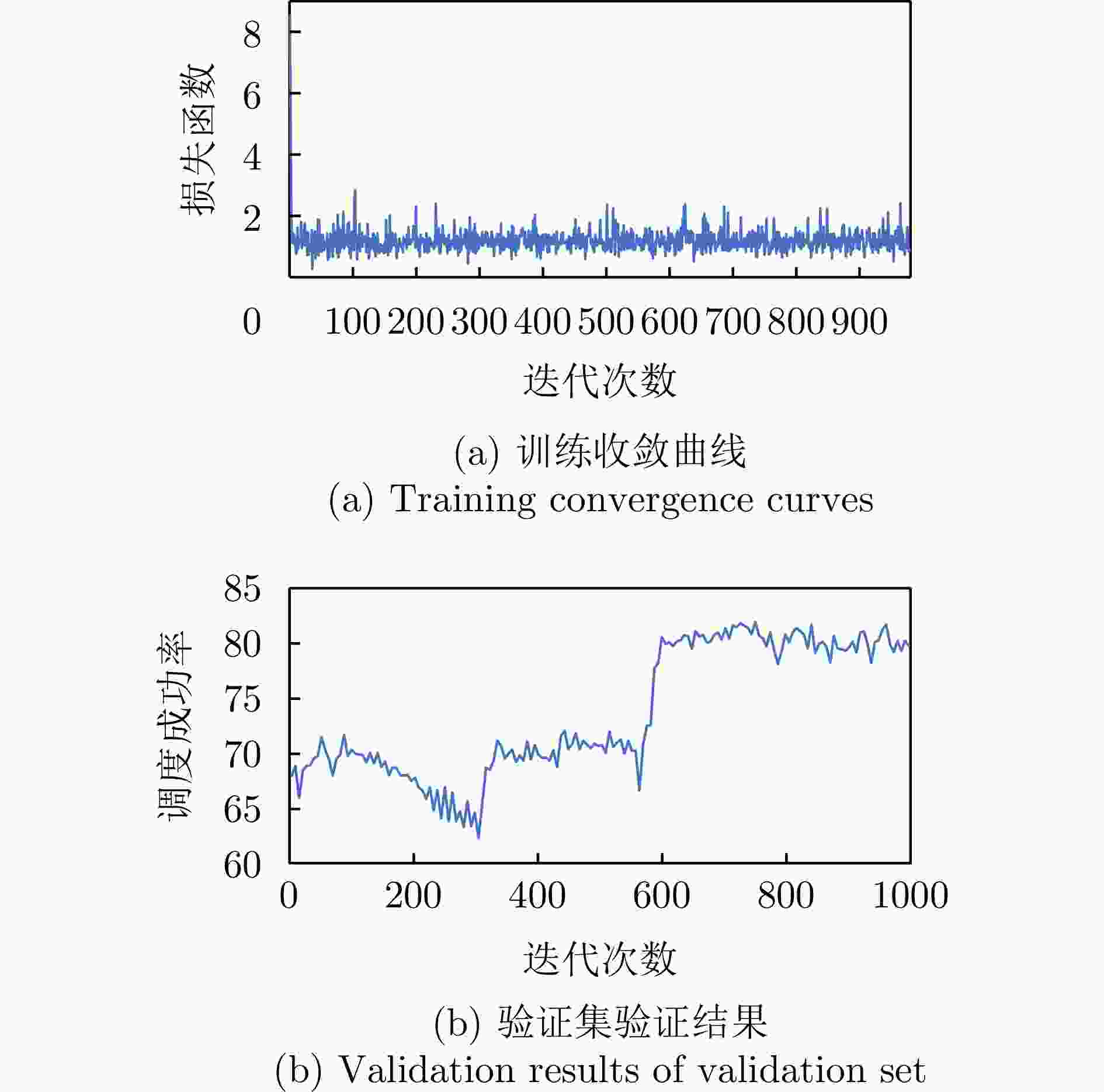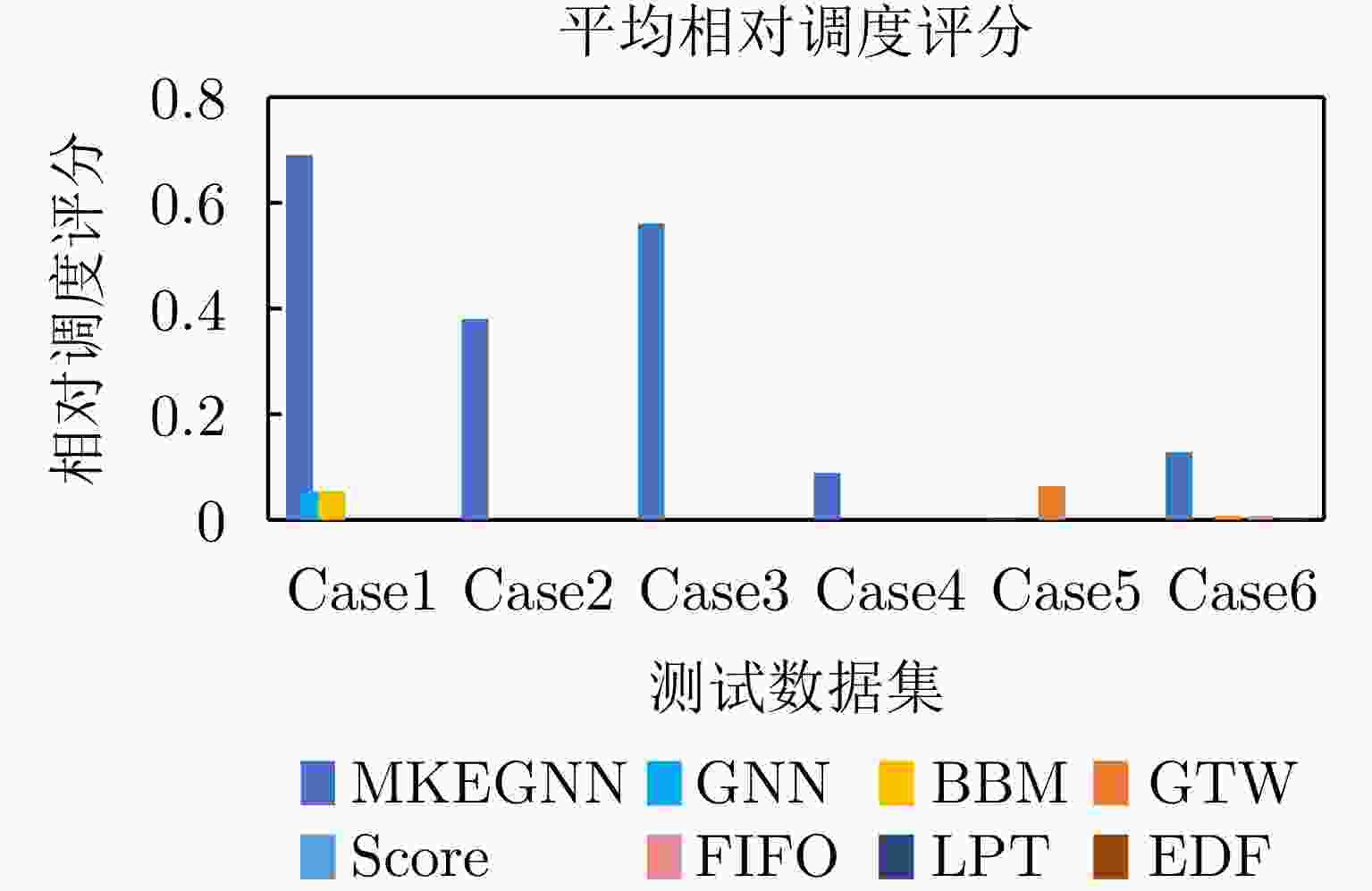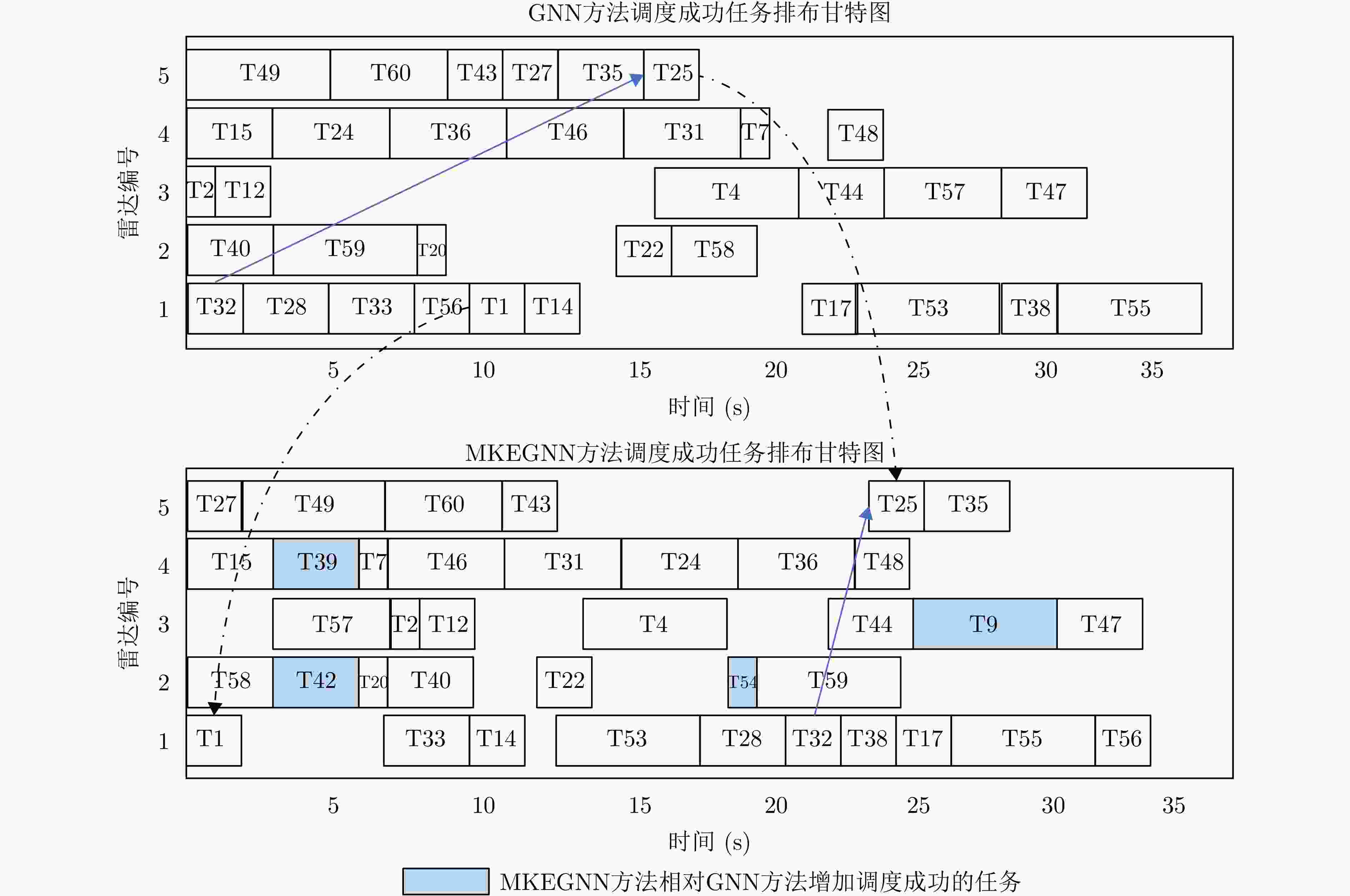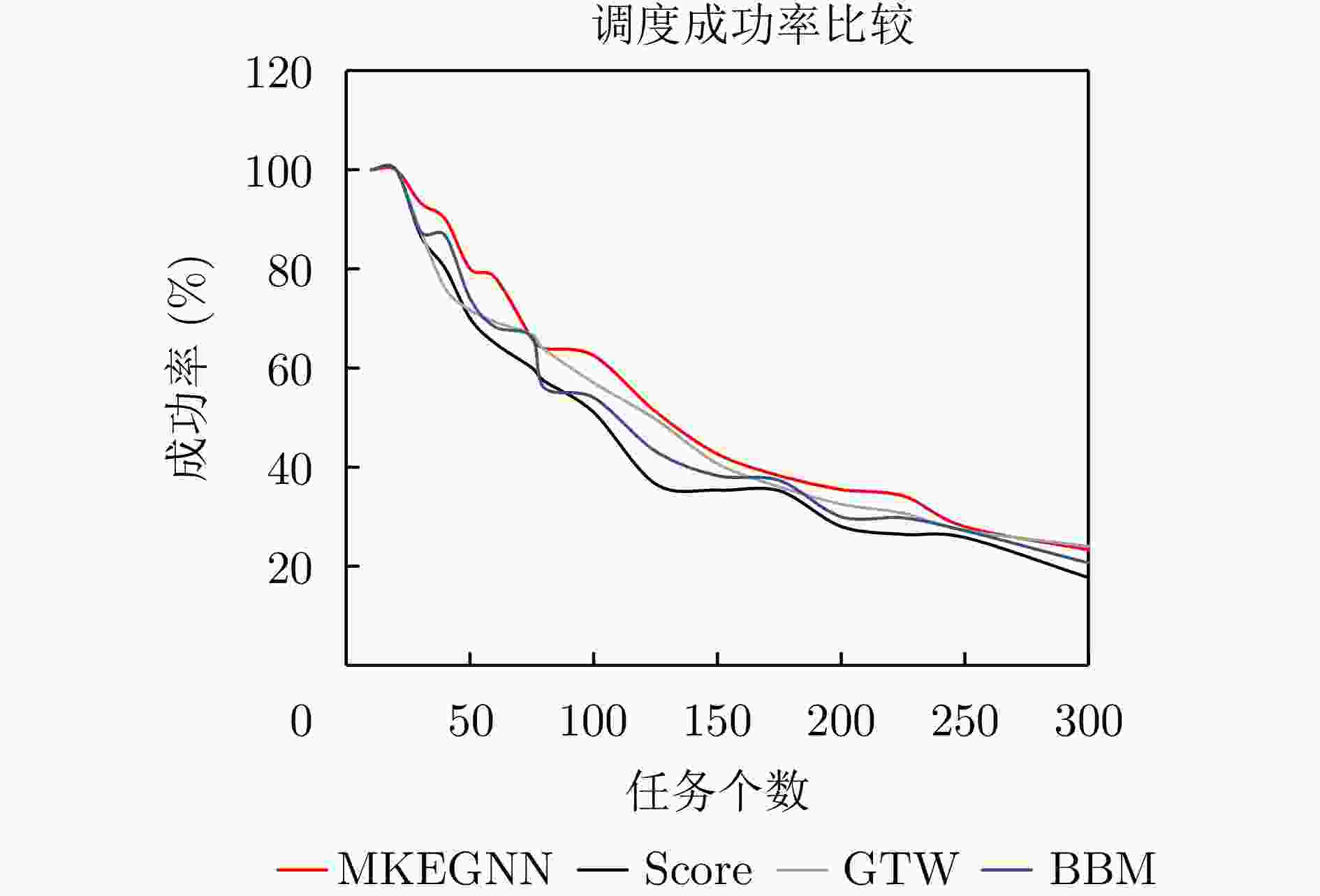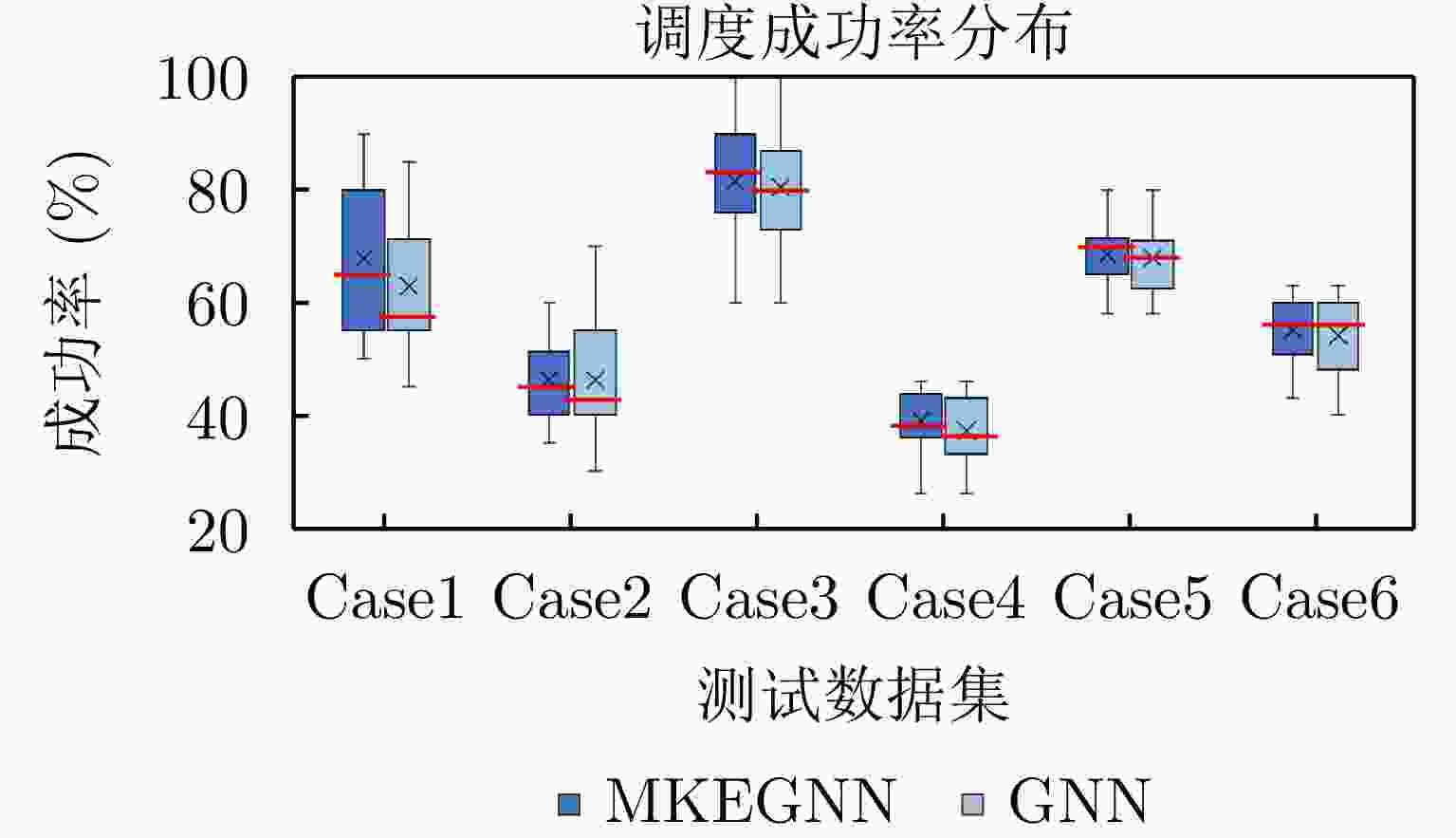Multiradar Collaborative Task Scheduling Algorithm Based on Graph Neural Networks with Model Knowledge Embedding
-
摘要: 现代雷达的探测、跟踪、识别等任务场景越来越复杂。任务类型的多变性,雷达资源的稀缺性和任务执行时间窗口的严格要求,使得雷达任务调度成为一类强NP-Hard问题。然而,现有的调度算法在处理涉及复杂逻辑约束的多雷达协同调度问题时适应性不足,效率不高。因此,基于人工智能(AI)的调度算法正在成为研究热点,但是AI调度算法的效率与其对问题特征的提取是否全面密切相关。如何能快速、全面地提取多雷达协同任务调度问题的共性特征,是提升这类AI调度算法效率的关键。因此,该文提出了基于模型知识融合的图神经网络(MKEGNN)调度算法。该算法首先将雷达任务协同调度问题建模为异构网络图模型,利用模型知识来优化GNN算法训练过程。算法创新在于:通过低复杂度的计算手段,获取模型的关键知识,进而优化GNN模型。在特征提取阶段,引入随机酉矩阵变换,利用任务异构图的随机拉普拉斯矩阵谱特征作为全局特征来强化图神经网络对共性特征的提取能力,弱化特定问题的个性化特征;在参数化决策阶段,利用由问题的引导解和经验解构成的上/下界结构知识从原理上减少决策空间大小,引导网络快速优化,加速决策学习过程的收敛。最后,进行了大量数据仿真实验。结果表明,相比目前的算法,MKEGNN算法对于所有任务集在稳定性和精度方面都有所提升,调度成功率性能提升3%~10%,加权调度成功率提升5%~15%。尤其当处理多雷达协同关系复杂的任务集时,任务调度成功率提升4%以上,算法稳定性和鲁棒性显著增强。Abstract: Modern radar systems face increasingly complex challenges in tasks such as detection, tracking, and identification. The diversity of task types, limited data resources, and strict execution time requirements make radar task scheduling a strongly NP-hard problem. However, existing scheduling algorithms struggle to efficiently handle multiradar collaborative tasks involving complex logical constraints. Therefore, Artificial Intelligence (AI)-based scheduling algorithms have gained significant attention. However, their efficiency is heavily dependent on effectively extracting the key features of the problem. The ability to quickly and comprehensively extract common features of multiradar scheduling problems is essential for improving the efficiency of such AI scheduling algorithms. Therefore, this paper proposes a Model Knowledge Embedded Graph Neural Network (MKEGNN) scheduling algorithm. This method frames the radar task collaborative scheduling problem as a heterogeneous network graph, leveraging model knowledge to optimize the training process of the Graph Neural Network (GNN) algorithm. A key innovation of this algorithm is its capability to capture critical model knowledge using low-complexity calculations, which helps to further optimize the GNN model. During the feature extraction stage, the algorithm employs a random unitary matrix transformation. This approach utilizes the spectral features of the random Laplacian matrix from the task’s heterogeneous graph as global features, enhancing the GNN’s ability to extract shared problem features while downplaying individual characteristics. In the parameterized decision-making stage, the algorithm leverages the upper and lower bound knowledge derived from guiding and empirical solutions of the problem model. This strategy significantly reduces the decision space, enabling the network to optimize quickly and accelerating the learning process. Extensive simulation experiments confirm the effectiveness of the MKEGNN algorithm. Compared to existing approaches, it demonstrates improved stability and accuracy across all task sets, boosting the scheduling success rate by 3%~10% and the weighted success rate by 5%~15%. For particularly challenging task sets involving complex multiradar collaborations, the success rate improves by over 4%. The results highlight the algorithm’s stability and robustness.
-
表 1 基于任务节点的7维度特征嵌入
Table 1. 7-dimensional feature embedding based on task nodes
序号 特征维度 特征说明 1 任务状态$ {\rm{ST}}_{{i}} $ 标识任务此前是否被调度过,已调度任务状态为$ {\rm{ST}}_{{i}}=1 $,否则为$ {\rm{ST}}_{{i}}=0 $ 2 处理时间$ {{p}}_{{i}} $ 雷达资源执行任务所需时间,包括准备时间 3 时间裕度tr 任务的截止期$ {{d}}_{{i}} $与雷达最早可用时间$ {{t}}_{{a}}^{{{m}}_{{i}}} $之差,反映任务的紧急程度 4 任务所关联雷达的未调度任务个数$ {{N}}_{{i}}^{{t}} $ $ {t} $时刻待处理任务队列中,与属于任务$ {i} $同属于雷达$ {{m}}_{{i}} $,且尚未调度的任务的个数 5 权重值$ {{\varphi}}_{{i}} $ 与任务优先级相关的权重值 6 入度弧个数$ {{E}}_{{i}} $ 表示有向弧中指向任务$ {i} $的弧的个数 7 同步弧个数$ {{{\mathrm{Syn}}}}_{{i}} $ 表示与任务$ {i} $同步任务的个数 表 2 不同参数任务数据集的全局特征
Table 2. Global characteristics of the dataset for different parameter tasks
参数 零特征值个数 最小非零特征值 谱半径 MSR 平均前置个数:1 9 0.7903 5.4809 2.3955 平均前置个数:2 0 0.0441 13.0964 7.9675 处理时间分布标准差:0 6 0.2592 4.9889 2.8304 处理时间分布标准差:2 6 0.5715 6.0868 1.9645 表 3 任务实例生成
Table 3. Task instance generation
大小 优先级 处理时间 截止期 前置任务个数 同步任务个数 10×3 U(1, 5) U(1, 5) U(8, 30) U(0, 3) U(0, 2) 20×3 U(1, 5) U(1, 5) U(8, 30) U(0, 3) U(0, 2) 20×10 U(1, 5) U(1, 5) U(12, 40) U(0, 3) U(0, 2) 30×5 U(1, 5) U(1, 5) U(12, 40) U(0, 3) U(0, 2) 注:U(a, b)表示在区间[a, b]上的随机分布。 表 4 不同规模数据训练模型的测试结果(成功率)(%)
Table 4. Test results (success rate) of models trained with datasets of different sizes (%)
测试集规模 10×3 20×3 20×10 30×5 10×3训练模型 96.10 83.35 97.90 84.40 20×3训练模型 94.60 80.50 96.75 80.63 20×10训练模型 95.10 80.50 96.95 80.57 30×5训练模型 93.40 80.30 96.45 81.03 表 5 任务参数
Table 5. Task parameters
类别 类型 数量 驻留时长 截止期 跟踪确认TC 6 10 9 250 高精度跟踪HPT 5 10 8 250 精度跟踪PT 4 15 6 100 普通跟踪NT 3 15 4 100 高优先级搜索HS 2 20 2 100 低优先级搜索LS 1 20 1 100 表 6 结果对比
Table 6. Comparison of results
方法 成功率(%) 加权成功率(%) 平均任务调度耗时(s) MKEGNN 86.17 85.67 0.773 GNN 81.91 82.98 0.703 BBM 79.79 79.18 0.726 GTW 75.53 80.89 0.570 Score 76.60 78.16 0.012 注:平均任务调度耗时=计算耗时/调度成功任务个数。 表 7 测试集实例生成
Table 7. Test instance generation
实例 任务数 雷达数 优先级 处理时间 截止期 前置任务个数 同步任务个数 Case1 20 3 U(1, 5) U(1, 5) U(8, 30) U(0, 1) U(0, 2) Case2 20 3 U(1, 5) U(1, 5) U(8, 30) U(0, 3) U(0, 2) Case3 30 5 U(1, 5) U(1, 5) U(12, 40) U(0, 1) U(0, 2) Case4 30 5 U(1, 5) U(1, 5) U(12, 40) U(0, 3) U(0, 2) Case5 60 5 U(1, 5) U(1, 5) U(16, 60) U(0, 1) U(0, 2) Case6 60 5 U(1, 5) U(1, 5) U(16, 60) U(0, 3) U(0, 2) 注:U(a, b)表示在区间[a, b]上的随机分布。 表 8 任务调度成功率(%)
Table 8. Success ratio of scheduling (%)
实例 MKEGNN GNN BBM GTW Score FIFO LPT EDF Case1 80.5 70.5 72.5 67.0 65.5 63.0 59.5 71.0 Case2 58.5 53.0 52.5 48.0 48.5 48.5 42.5 50.5 Case3 90.3 81.6 78.6 79.0 77.6 72.3 70.7 81.0 Case4 52.0 49.7 45.7 52.0 48.0 45.3 47.3 46.0 Case5 85.7 85.6 70.2 80.2 72.7 66.5 63.3 77.8 Case6 45.0 44.2 40.8 42.0 40.0 39.4 39.5 40.8 表 9 任务加权调度成功率(%)
Table 9. Weighted success ratio of scheduling (%)
实例 MKEGNN GNN BBM GTW Score FIFO LPT EDF Case1 81.9 69.9 71.2 68.5 63.9 61.1 58.2 70.8 Case2 61.3 54.7 55.2 50.4 50.9 50.7 44.9 53.0 Case3 90.8 80.9 79.4 80.0 78.4 72.6 70.6 81.0 Case4 52.7 50.1 44.8 52.5 47.8 44.4 47.1 46.0 Case5 86.2 81.0 70.0 82.2 74.0 65.5 63.7 78.1 Case6 46.6 44.0 42.5 43.8 41.0 41.2 41.1 42.9 表 10 各优先级任务调度成功率(%)
Table 10. Success ratio of scheduling of different priority (%)
优先级 MKEGNN GNN BBM GTW Score FIFO LPT EDF 5 88.8 66.6 88.8 88.8 88.8 66.7 55.6 77.8 4 100 100 83.3 83.3 83.3 83.3 100 100 3 100 50.0 50.0 50.0 75.0 25.0 75.0 75.0 2 80.0 60.0 60.0 40.0 60.0 80.0 80.0 60.0 1 83.3 83.3 83.3 100 83.3 50.0 50.0 83.3 -
[1] 古龙, 唐佳, 罗昀, 等. 基于多维资源管理的多功能雷达任务调度算法[J]. 现代雷达, 2023, 45(10): 73–79. doi: 10.16592/j.cnki.1004-7859.2023.10.009.GU Long, TANG Jia, LUO Yun, et al. A multifunctional radar task scheduling algorithm based on multidimensional resource management[J]. Modern Radar, 2023, 45(10): 73–79. doi: 10.16592/j.cnki.1004-7859.2023.10.009. [2] 黄洁瑜, 谢军伟, 杨子晴, 等. 雷达资源管理技术发展研究综述[J/OL]. 现代雷达, 待出版. https://link.cnki.net/urlid/32.1353.tn.20231229.0910.002.HUANG Jieyu, XIE Junwei, YANG Ziqing, et al. A review of radar resource management technology development research[J]. Modern Radar, in press. https://link.cnki.net/urlid/32.1353.tn.20231229.0910.002. [3] 钱国栋. 岸基多功能相控阵雷达发展需求和发展方向探讨[J]. 雷达与对抗, 2014, 34(2): 11–13. doi: 10.19341/j.cnki.issn.1009-0401.2014.02.004.QIAN Guodong. Development demand and direction of shore-based multifunctional phased array radars[J]. Radar & ECM, 2014, 34(2): 11–13. doi: 10.19341/j.cnki.issn.1009-0401.2014.02.004. [4] 赵佳音, 赵四方. 岸基综合电子战系统设计思考[J]. 舰船电子工程, 2021, 41(7): 9–11, 39. doi: 10.3969/j.issn.1672-9730.2021.07.002.ZHAO Jiayin and ZHAO Sifang. Design of shore based integrated electronic warfare system[J]. Ship Electronic Engineering, 2021, 41(7): 9–11, 39. doi: 10.3969/j.issn.1672-9730.2021.07.002. [5] 卢建斌, 胡卫东, 郁文贤. 多功能相控阵雷达实时任务调度研究[J]. 电子学报, 2006, 34(4): 732–736. doi: 10.3321/j.issn:0372-2112.2006.04.032.LU Jianbin, HU Weidong, and YU Wenxian. Study on real-time task scheduling of multifunction phased array radars[J]. Acta Electronica Sinica, 2006, 34(4): 732–736. doi: 10.3321/j.issn:0372-2112.2006.04.032. [6] 丁海婷, 周琳, 刁伟峰. 基于背包问题的多相控阵雷达多目标跟踪时间资源管理算法[J]. 兵工学报, 2021, 42(5): 997–1003. doi: 10.3969/j.issn.1000-1093.2021.05.012.DING Haiting, ZHOU Lin, and DIAO Weifeng. Knapsack problem-based algorithm for time resource management of multiple phased array radars for multiple targets tracking[J]. Acta Armamentarii, 2021, 42(5): 997–1003. doi: 10.3969/j.issn.1000-1093.2021.05.012. [7] 易伟, 袁野, 刘光宏, 等. 多雷达协同探测技术研究进展: 认知跟踪与资源调度算法[J]. 雷达学报, 2023, 12(3): 471–499. doi: 10.12000/JR23036.YI Wei, YUAN Ye, LIU Guanghong, et al. Recent advances in multi-radar collaborative surveillance: Cognitive tracking and resource scheduling algorithms[J]. Journal of Radars, 2023, 12(3): 471–499. doi: 10.12000/JR23036. [8] 刘宏伟, 严俊坤, 张鹏, 等. 一种面向多任务调度的相控阵雷达资源管理方法[J]. 现代雷达, 2023, 45(6): 8–16. doi: 10.16592/j.cnki.1004-7859.2023.06.002.LIU Hongwei, YAN Junkun, ZHANG Peng, et al. A multi-task oriented resource management method for phased array radar[J]. Modern Radar, 2023, 45(6): 8–16. doi: 10.16592/j.cnki.1004-7859.2023.06.002. [9] JEFFAY K, STANAT D F, and MARTEL C U. On non-preemptive scheduling of period and sporadic tasks[C]. Proceedings Twelfth Real-Time Systems Symposium, San Antonio, TX, USA, 1991: 129–139. doi: 10.1109/REAL.1991.160366. [10] 韦刚, 刘昌云, 郭相科. 基于多属性决策的相控阵雷达截获任务规划算法[J]. 现代雷达, 2016, 38(10): 42–46. doi: 10.16592/j.cnki.1004-7859.2016.10.011.WEI Gang, LIU Changyun, and GUO Xiangke. Algorithms of search mission planning in phased array radar based on multi-attribute decision[J]. Modern Radar, 2016, 38(10): 42–46. doi: 10.16592/j.cnki.1004-7859.2016.10.011. [11] 朱希同, 杨瑞娟, 李晓柏, 等. 一种多功能天波超视距雷达任务规划调度方法[J]. 舰船电子工程, 2022, 42(2): 75–80. doi: 10.3969/j.issn.1672-9730.2022.02.016.ZHU Xitong, YANG Ruijuan, LI Xiaobai, et al. A multifunctional sky-wave over-the-horizon radar task planning and scheduling method[J]. Ship Electronic Engineering, 2022, 42(2): 75–80. doi: 10.3969/j.issn.1672-9730.2022.02.016. [12] 程婷, 恒思宇, 李中柱. 基于脉冲交错的分布式雷达组网系统波束驻留调度[J]. 雷达学报, 2023, 12(3): 616–628. doi: 10.12000/JR22211.CHENG Ting, HENG Siyu, and LI Zhongzhu. Real-time dwell scheduling algorithm for distributed phased array radar network based on pulse interleaving[J]. Journal of Radars, 2023, 12(3): 616–628. doi: 10.12000/JR22211. [13] 段毅, 谭贤四, 曲智国, 等. 基于分支定界法的相控阵雷达事件调度算法[J]. 电子学报, 2019, 47(6): 1309–1315. doi: 10.3969/j.issn.0372-2112.2019.06.018.DUAN Yi, TAN Xiansi, QU Zhiguo, et al. Phased array radar task scheduling algorithm based on branch and bound method[J]. Acta Electronica Sinica, 2019, 47(6): 1309–1315. doi: 10.3969/j.issn.0372-2112.2019.06.018. [14] 袁野, 杨剑, 刘辛雨, 等. 基于任务效用最大化的多雷达协同任务规划算法[J]. 雷达学报, 2023, 12(3): 550–562. doi: 10.12000/JR23013.YUAN Ye, YANG Jian, LIU Xinyu, et al. Multiradar collaborative task planning based ontask utility maximization[J]. Journal of Radars, 2023, 12(3): 550–562. doi: 10.12000/JR23013. [15] 时晨光, 董璟, 周建江. 频谱共存下面向多目标跟踪的组网雷达功率时间联合优化算法[J]. 雷达学报, 2023, 12(3): 590–601. doi: 10.12000/JR22146.SHI Chenguang, DONG Jing, and ZHOU Jianjiang. Joint transmit power and dwell time allocation for multitarget tracking in radar networks under spectral coexistence[J]. Journal of Radars, 2023, 12(3): 590–601. doi: 10.12000/JR22146. [16] 宋晓程, 李陟, 任海伟, 等. 目标动态威胁度驱动的分布式组网相控阵雷达资源优化分配算法[J]. 雷达学报, 2023, 12(3): 629–641. doi: 10.12000/JR22240.SONG Xiaocheng, LI Zhi, REN Haiwei, et al. Target-driven resource allocation algorithm for distributed netted phased array radars[J]. Journal of Radars, 2023, 12(3): 629–641. doi: 10.12000/JR22240. [17] 赵宇, 李建勋, 曹兰英, 等. 基于二次规划的相控阵雷达任务自适应调度算法[J]. 系统工程与电子技术, 2012, 34(4): 698–703. doi: 10.3969/j.issn.1001-506X.2012.04.11.ZHAO Yu, LI Jianxun, CAO Lanying, et al. Adaptive scheduling algorithm based on quadratic programming for multifunction phased array radars[J]. Systems Engineering and Electronics, 2012, 34(4): 698–703. doi: 10.3969/j.issn.1001-506X.2012.04.11. [18] ZHANG Haowei, XIE Junwei, GE Jiaang, et al. Optimization model and online task interleaving scheduling algorithm for MIMO radar[J]. Computers & Industrial Engineering, 2018, 127: 865–874. doi: 10.1016/j.cie.2018.11.024. [19] ZHANG Haowei, XIE Junwei, HU Qiyong, et al. A hybrid DPSO with Levy flight for scheduling MIMO radar tasks[J]. Applied Soft Computing, 2018, 71: 242–254. doi: 10.1016/j.asoc.2018.06.028. [20] ZHANG Haowei, XIE Junwei, HU Qiyong, et al. An entropy-based PSO for DAR task scheduling problem[J]. Applied Soft Computing, 2018, 73: 862–873. doi: 10.1016/j.asoc.2018.09.022. [21] 李纪三, 纪彦星, 曹鼎, 等. 基于广义时间窗的旋转相控阵雷达资源调度算法[J]. 电子学报, 2022, 50(5): 1050–1057. doi: 10.12263/DZXB.20210414.LI Jisan, JI Yanxing, CAO Ding, et al. Resource scheduling algorithm of rotating phased array radar based on generalized time window[J]. Acta Electronica Sinica, 2022, 50(5): 1050–1057. doi: 10.12263/DZXB.20210414. [22] WANG Gaige, GAO Da, and PEDRYCZ W. Solving multiobjective fuzzy job-shop scheduling problem by a hybrid adaptive differential evolution algorithm[J]. IEEE Transactions on Industrial Informatics, 2022, 18(12): 8519–8528. doi: 10.1109/TII.2022.3165636. [23] TIAN Tuanwei, ZHANG Tianxian, and KONG Lingjiang. Timeliness constrained task scheduling for multifunction radar network[J]. IEEE Sensors Journal, 2019, 19(2): 525–534. doi: 10.1109/JSEN.2018.2878795. [24] PARK Y and BASKIYAR S. Adaptive scheduling on heterogeneous systems using support vector machine[J]. Computing, 2017, 99(4): 405–425. doi: 10.1007/s00607-016-0513-x. [25] GUPTA J N D, MAJUMDER A, and LAHA D. Flowshop scheduling with artificial neural networks[J]. Journal of the Operational Research Society, 2020, 71(10): 1619–1637. doi: 10.1080/01605682.2019.1621220. [26] SHAGHAGHI M and ADVE R S. Machine learning based cognitive radar resource management[C]. 2018 IEEE Radar Conference, Oklahoma City, 2018: 1433–1438. doi: 10.1109/RADAR.2018.8378775. [27] SONG Wen, CHEN Xinyang, LI Qiqiang, et al. Flexible job-shop scheduling via graph neural network and deep reinforcement learning[J]. IEEE Transactions on Industrial Informatics, 2023, 19(2): 1600–1610. doi: 10.1109/TII.2022.3189725. [28] ANSOLA P G, HIGUERA A G, OTAMENDI F J, et al. Agent-based distributed control for improving complex resource scheduling: Application to airport ground handling operations[J]. IEEE Systems Journal, 2014, 8(4): 1145–1157. doi: 10.1109/JSYST.2013.2272248. [29] QU Zhen, DING Zhen, and MOO P. A machine learning task selection method for radar resource management (poster)[C]. 2019 22th International Conference on Information Fusion, Ottawa, Canada, 2019: 1–6. doi: 10.23919/FUSION43075.2019.9011342. [30] ZHOU Longfei, ZHANG Lin, and HORN B K P. Deep reinforcement learning-based dynamic scheduling in smart manufacturing[J]. Procedia CIRP, 2020, 93: 383–388. doi: 10.1016/j.procir.2020.05.163. [31] 王跃东, 顾以静, 梁彦, 等. 伴随压制干扰与组网雷达功率分配的深度博弈研究[J]. 雷达学报, 2023, 12(3): 642–656. doi: 10.12000/JR23023.WANG Yuedong, GU Yijing, LIANG Yan, et al. Deep game of escorting suppressive jamming and networked radar power allocation[J]. Journal of Radars, 2023, 12(3): 642–656. doi: 10.12000/JR23023. [32] KUO Teiwei, CHAO Yungsheng, KUO Chinfu, et al. Real-time dwell scheduling of component-oriented phased array radars[J]. IEEE Transactions on Computers, 2005, 54(1): 47–60. doi: 10.1109/TC.2005.10. [33] MIR H S and GUITOUNI A. Variable dwell time task scheduling for multifunction radar[J]. IEEE Transactions on Automation Science and Engineering, 2014, 11(2): 463–472. doi: 10.1109/TASE.2013.2285014. [34] PINEDO M L. Scheduling: Theory, Algorithms, and Systems[M]. New York: Springer Publishing Company, 2008: 179–182. [35] BURAK C. Non-Hermitian random matrix theory for MIMO channels[D]. [Master dissertation], Norwegian University of Science and Technology, 2012: 18–20. [36] KRUZICK S and MOURA J M F. Optimal filter design for signal processing on random graphs: Accelerated consensus[J]. IEEE Transactions on Signal Processing, 2018, 66(5): 1258–1272. doi: 10.1109/TSP.2017.2784359. [37] SHI Xin and QIU R. Power system real-time operation situation assessment based on random matrix theory[C]. 2020 IEEE Power & Energy Society General Meeting, Montreal, QC, 2020: 1–5. doi: 10.1109/PESGM41954.2020.9281475. [38] PETERS T. Data-driven science and engineering: Machine learning, dynamical systems, and control[J]. Contemporary Physics, 2019, 60(4): 320. doi: 10.1080/00107514.2019.1665103. [39] WANG Zekun, CHEN Hongjia, TENG Zhongming, et al. On perturbations for spectrum and singular value decompositions followed by deflation techniques[J]. Applied Mathematics Letters, 2025, 160: 109332. doi: 10.1016/j.aml.2024.109332. [40] ZHOU Jie, CUI Ganqu, HU Shengding, et al. Graph neural networks: A review of methods and applications[J]. AI Open, 2020, 1: 57–81. doi: 10.1016/j.aiopen.2021.01.001. [41] SHORT M. Improved schedulability analysis of implicit deadline tasks under limited preemption EDF scheduling[C]. ETFA2011, Toulouse, France, 2011: 1–8. doi: 10.1109/ETFA.2011.6059008. [42] LIU C L and LAYLAND J W. Scheduling algorithms for multiprogramming in a hard-real-time environment[J]. Journal of the ACM (JACM), 1973, 20(1): 46–61. doi: 10.1145/321738.321743. -



 作者中心
作者中心 专家审稿
专家审稿 责编办公
责编办公 编辑办公
编辑办公

 下载:
下载:

